Saltzman B. (editor) Anomalous Atmospheric Flows and Blocking
Подождите немного. Документ загружается.

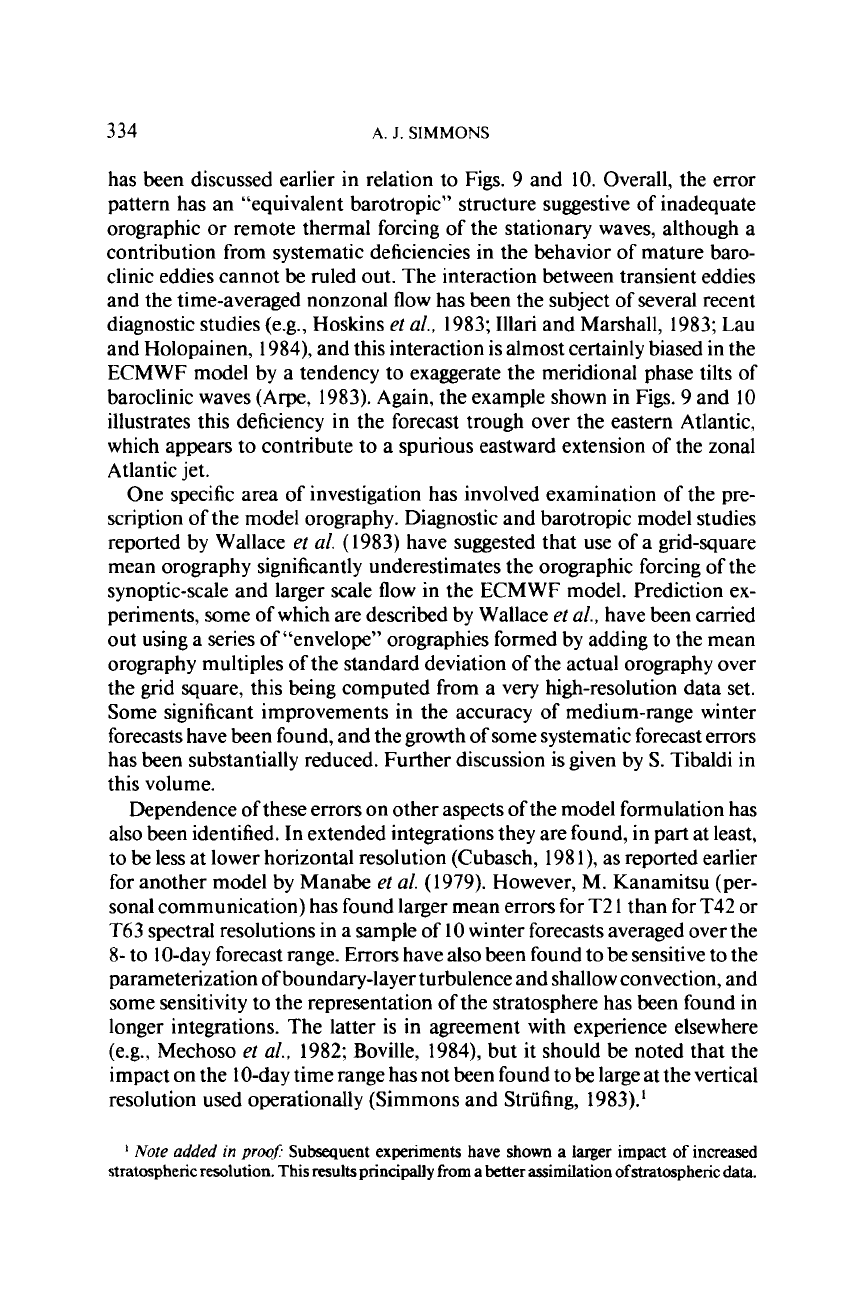
3
34
A.
J.
SIMMONS
has been discussed earlier in relation to Figs. 9 and
10.
Overall, the error
pattern has an “equivalent barotropic” structure suggestive of inadequate
orographic
or
remote thermal forcing of the stationary waves, although a
contribution from systematic deficiencies in the behavior of mature baro-
clinic eddies cannot be ruled out. The interaction between transient eddies
and the time-averaged nonzonal flow has been the subject of several recent
diagnostic studies (e.g., Hoskins
ef
af.,
1983; Illari and Marshall, 1983; Lau
and Holopainen, 1984), and this interaction is almost certainly biased in the
ECMWF model by a tendency to exaggerate the meridional phase tilts
of
baroclinic waves (Arpe, 1983). Again, the example shown in Figs. 9 and
10
illustrates this deficiency in the forecast trough over the eastern Atlantic,
which appears to contribute to a spurious eastward extension of the zonal
Atlantic jet.
One specific area of investigation has involved examination of the pre-
scription of the model orography. Diagnostic and barotropic model studies
reported by Wallace
ef
af.
(1983) have suggested that use of a grid-square
mean orography significantly underestimates the orographic forcing of the
synoptic-scale and larger scale flow in the ECMWF model. Prediction ex-
periments, some of which are described by Wallace
et
al.,
have been camed
out using a series
of
“envelope” orographies formed by adding to the mean
orography multiples of the standard deviation of the actual orography over
the grid square, this being computed from a very high-resolution data set.
Some significant improvements in the accuracy of medium-range winter
forecasts have been found, and the growth of some systematic forecast errors
has been substantially reduced. Further discussion is given by S. Tibaldi in
this volume.
Dependence
of
these errors on other aspects
of
the model formulation has
also been identified. In extended integrations they are found, in part at least,
to be less at lower horizontal resolution (Cubasch, 198
l),
as reported earlier
for another model by Manabe et
al.
(1979). However, M. Kanamitsu (per-
sonal communication) has found larger mean errors for
T2
1
than for T42 or
T63
spectral resolutions in a sample
of
10
winter forecasts averaged over the
8-
to 10-day forecast range.
Errors
have also been found to be sensitive to the
parameterization
of
boundary-layer turbulence and shallow convection, and
some sensitivity to the representation of the stratosphere has been found in
longer integrations. The latter is in agreement with experience elsewhere
(e.g., Mechoso
et
al.,
1982; Boville, 1984), but it should be noted that the
impact on the
1
0-day time range has not been found to
be
large at the vertical
resolution used operationally (Simmons and Striifing, 1983).’
Note added
in
proqt
Subsequent experiments have shown a
larger
impact of increased
stratospheric resolution. This results principally from
a
better assimilation ofstratospheric
data.
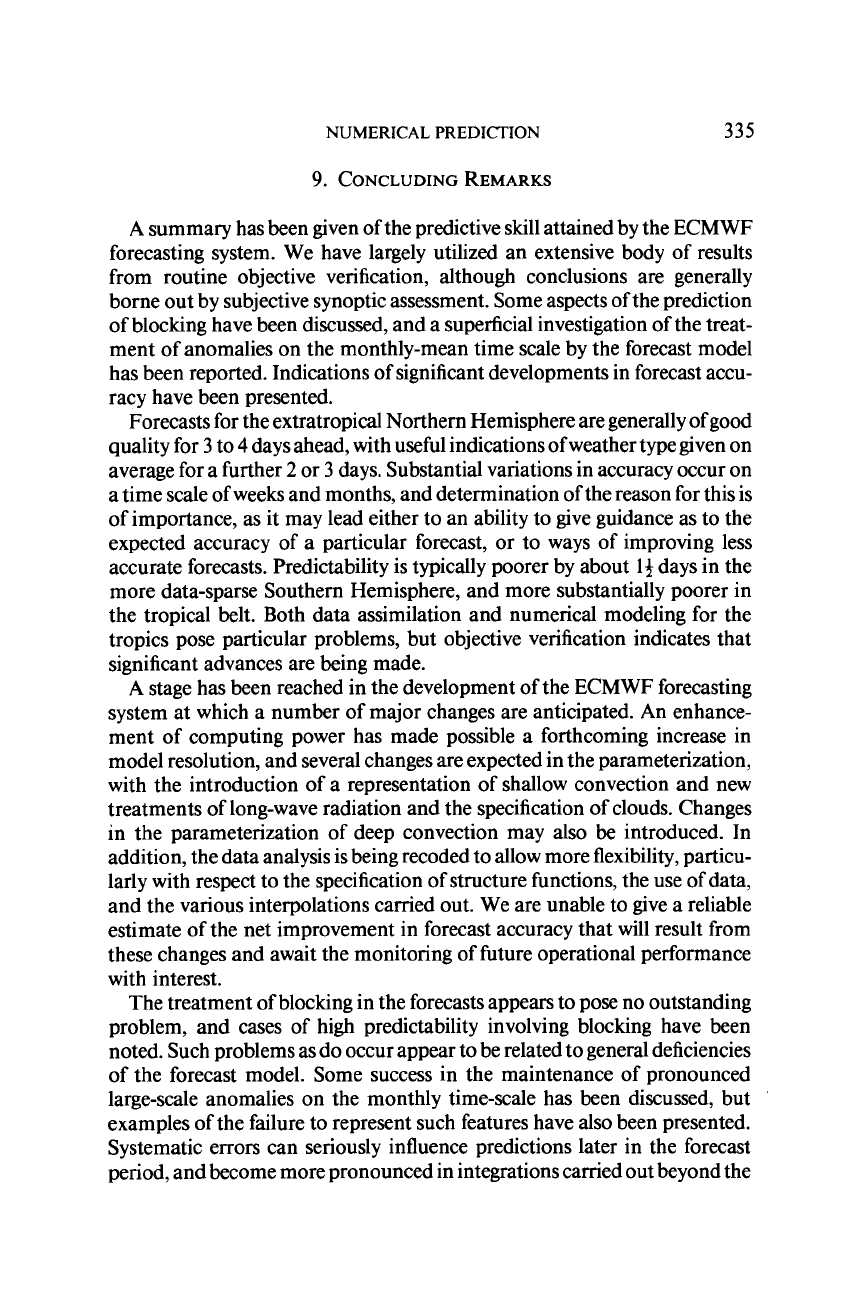
NUMERICAL PREDICTION
335
9.
CONCLUDING
REMARKS
A summary has been given of the predictive skill attained by the ECMWF
forecasting system. We have largely utilized an extensive body of results
from routine objective verification, although conclusions are generally
borne out by subjective synoptic assessment. Some aspects of the prediction
of blocking have been discussed, and a superficial investigation of the treat-
ment of anomalies on the monthly-mean time scale by the forecast model
has been reported. Indications of significant developments in forecast accu-
racy have been presented.
Forecasts for the extratropical Northern Hemisphere are generally of good
quality for
3
to
4
days ahead, with useful indications of weather type given on
average for a further
2
or
3
days. Substantial variations in accuracy occur on
a time scale of weeks and months, and determination of the reason for this is
of importance, as it may lead either to an ability to give guidance as to the
expected accuracy of a particular forecast, or to ways of improving less
accurate forecasts. Predictability is typically poorer by about
13
days in the
more data-sparse Southern Hemisphere, and more substantially poorer in
the tropical belt. Both data assimilation and numerical modeling for the
tropics pose particular problems, but objective verification indicates that
significant advances are being made.
A
stage has been reached in the development of the ECMWF forecasting
system at which a number
of
major changes are anticipated. An enhance-
ment of computing power has made possible a forthcoming increase in
model resolution, and several changes are expected in the parameterization,
with the introduction of a representation of shallow convection and new
treatments of long-wave radiation and the specification of clouds. Changes
in
the parameterization of deep convection may also be introduced. In
addition, the data analysis is being recoded to allow more flexibility, particu-
larly with respect to the specification of structure functions, the use of data,
and the various interpolations carried out. We are unable to give a reliable
estimate of the net improvement in forecast accuracy that will result from
these changes and await the monitoring of future operational performance
with interest.
The treatment of blocking in the forecasts appears to pose no outstanding
problem, and cases of high predictability involving blocking have been
noted. Such problems as do occur appear to be related to general deficiencies
of the forecast model. Some success in the maintenance of pronounced
large-scale anomalies on the monthly time-scale has been discussed, but
examples of the failure to represent such features have also been presented.
Systematic errors can seriously influence predictions later in the forecast
period, and become more pronounced in integrations carried out beyond the
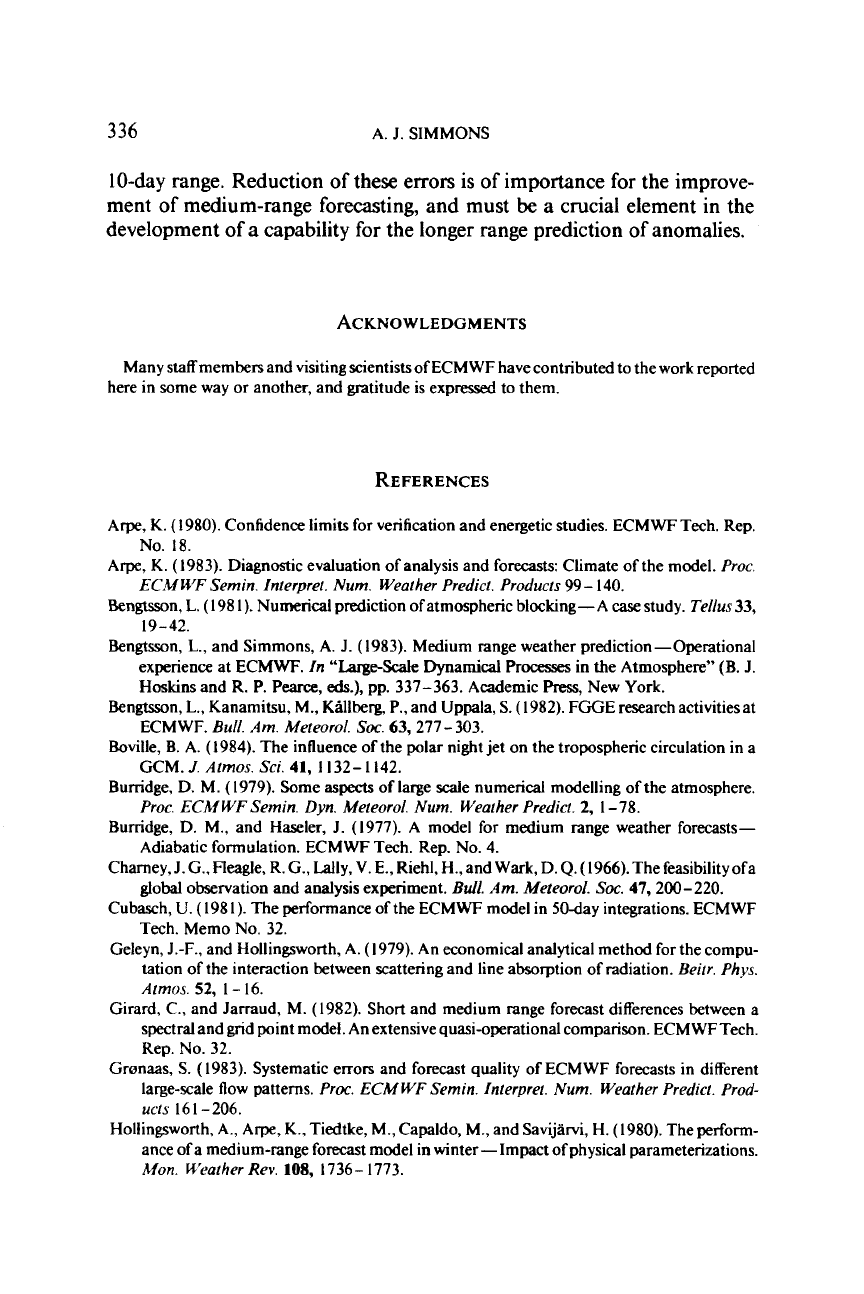
336
A. J. SIMMONS
10-day range. Reduction
of
these errors is of importance for the improve-
ment of medium-range forecasting, and must
be
a crucial element in the
development
of
a capability for the longer range prediction of anomalies.
ACKNO
w
LEDGMENTS
Many staff members and visiting scientists of ECMWF havecontributed to the work reported
here in some way
or
another, and gmtitude is expressed to them.
REFERENCES
Arpe, K.
(1
980). Confidence limits for verification and energetic studies. ECMWF Tech. Rep.
Arpe,
K.
(1983). Diagnostic evaluation of analysis and forecasts: Climate of the model.
Proc.
Bengtsson,
L.
(198
1).
Numerical
prediction ofatmospheric blocking-A
case
study.
Tellus33,
Bengtsson,
L.,
and Simmons, A.
J.
(1983). Medium range weather prediction-Operational
experience at ECMWF.
In
“Large-!jcale
Dynamical
Processes
in the Atmosphere” (B. J.
Hoskins and
R.
P.
Pearce,
eds.),
pp.
337-363. Academic Press, New
York.
Bemgtsson,
L.,
Kanamitsu, M.,
KAIIberg,
P.,
and Uppala,
S.
(1982). FGGE research activitie sat
ECMWF.
Bull.
Am Meteorol.
Soc.
63,277
-
303.
Boville,
B.
A.
(1984). The influence
of
the polar night jet on the tropospheric circulation in a
GCM.
J.
Amos.
Sci.
41,1132- 1142.
Bumdge, D. M. (1979). Some
aspects
of large scale numerical modelling of the atmosphere.
Proc. ECMWF Semin.
Dyn.
Meteorol. Num. Weather Predicl.
2,
1-78.
Bumdge, D. M., and Haler, J. (1977).
A
model for medium range weather forecasts-
Adiabatic formulation. ECMWF Tech. Rep. No. 4.
Charney, J. G., Reagle,
R.
G., Mly,
V.
E., Riehl, H., and Wark,
D.
Q.
(1966). The feasibility ofa
global
observation and analysis experiment.
Bull.
Am.
Meteorol.
Soc.
47,200-220.
Cubasch,
U.
(198
1).
The performance of the ECMWF model in 5May integrations. ECMWF
Tech. Memo No. 32.
Geleyn, J.-F., and Hollingsworth,
A.
(1979). An economical analytical method for the compu-
tation of the interaction between scattering and line absorption
of
radiation.
Beitr. Phys.
Amos.
52,
1
-
16.
Girard,
C.,
and Jarraud,
M.
(1982). Short and medium range forecast differences between
a
spectral and grid point model. An extensive quasi-operational comparison. ECMWFTech.
Rep.
No.
32.
Gronaas,
S.
(1983). Systematic errors and forecast quality of ECMWF forecasts in different
large-scale flow patterns.
Proc. ECMWF Semin. Interpret. Num. Weather Predict. Prod-
Hollingsworth, A,, Arpe,
K.,
Tiedtke, M., Capaldo, M., and Savijarvi,
H.
(
1980). The perform-
ance ofa medium-range forecast model in winter-Impact ofphysical parameterizations.
hfon.
U‘eather Rev.
108, 1736- 1773.
No.
18.
ECMWF Semin. Interpret. Num. Weather Predict. Products
99
-
140.
19-42.
uct~
161 -206.

NUMERICAL PREDICTION
337
Hoskins, B. J., James, I., and White, G.
H.
(1983).
The shape, propagation and mean-flow
interaction of large-scale weather systems.
J.
Atmos.
Sci.
40, 1595-6 12.
Illari, L., and Marshall, J. C.
(1983).
On
the interpretation of eddy fluxes during a blocking
episode.
J.
Atmos.
Sci.
40,2232-2242.
Ji, L. R., and Tibaldi,
S.
(1983).
Numerical simulations of a case of blocking. The effects of
orography and land-sea contrast.
Mon.
Weather Rev.
1 11,2068
-
2086.
Kuo,
H. L.
(
1974).
Further studies ofthe influence of cumulus convection
on
large-scale flow.
J.
Atmos.
Sci.
31, 1232-1240.
Lange, A., and Hellsten, E.
(1984).
Results of the WMO/CAS NWP Data Study and Intercom-
parison Project for forecasts for the Northern Hemisphere in
1983.
WMO Geneva.
Lau, N.-C., and Holopainen,
E.
0.
(1984).
Transient eddy forcing of the time-mean flow as
identified by geopotential tendencies.
J.
Atmos.
Sci.
41, 3 13-328.
Lorenc,
A.
C.
(
I98
1).
A
global three-dimensional multivariate statistical interpolation scheme.
Mon.
Weather Rev.
109, 70
I
-
72
1.
Lorenz, E.
N.
(1975).
Climate Predictability, GARP Publication Series No.
16,
pp.
132- 136.
WMO, Geneva.
Lorenz,
E.
N.
(1982).
Atmospheric predictability experiments with
a
large numerical model.
Tellus
34,
505
-
5
13.
Louis, J.-F.
(1979).
A
parametric model of vertical eddy fluxes in the atmosphere.
Boundary-
Layer Meteorol.
17, 187-202.
Manabe,
S.,
Hahn, D. G., and Holloway, J. L.
(1979).
Climate simulation with GFDL spectral
models of the atmosphere: Effect of spectral truncation. GARP.Publication Series No.
22,
4
1
-
94.
WMO, Geneva.
Mechoso, C. R., Suarez, M. J., Yamazaki,
K.,
Spahr, J. A., and Arakawa, A.
(1982).
A
study of
the sensitivity of numerical forecasts to
an upper boundary in the lower stratosphere.
Mon.
Weather Rev.
110,
1984-93.
Miyakoda,
K.,
Hembree, G. D., Stricker, R. F., and Shulman,
I.
(1972).
Cumulative results of
extended forecast experiments.
I:
Model performance for winter cases.
Mon.
Weather Rev.
Miyakoda,
K.,
Gordon,
T.,
Caverly, R., Stem, W., Sirutis, J., and Bourke, W.
(1983).
Simula-
Nieminen, R.
(
1983).
Operational verification of ECMWF forecast fields and results for
1980-
Shukia,
J.
(1981).
Dynamical predictability of monthly means.
J.
Atmos.
Sci.
38,2547 -2572.
Simmons, A. J., and Bengtsson, L.
(1984).
Atmospheric general circulation models. Their
design and
use
for climate studies.
In
“The Global Climate” (J. T. Houghton, ed.), pp.
37-62.
Cambridge University Press, London.
Simmons, A. J., and Bumdge,
D.
M.
(1981).
An energy and angular momentum conserving
vertical finite difference scheme and hybrid vertical coordinates.
Mon.
Weather Rev.
109,
Simmons, A. J., and Hoskins, B.
J.
(1978).
The life cycles of some nonlinear baroclinic waves.
J.
Atmos.
Sci.
35,414-432.
Simmons, A. J., and Jarraud, M.
(1984).
The design and performance of the new ECMWF
operational model.
Proc.
ECMWF
Semin.
Num.
Meth. Weather
Predict.,
1
13- 164.
Simmons, A. J., and Striifing, R.
(1983).
Numerical forecasts of stratospheric warming events
using a model with a hybrid vertical coordinate
Q.J.R. Meteorol.
SOC.
109, 8
I
-
I
1
1.
Smagorinsky, J.
(1
969).
Problems and promises of deterministic extended range forecasting.
Bull.
Am.
Meteorol.
SOC. 50,
286-3
1
1.
Temperton, C., and Williamson, D. L.
(198
1).
Normal mode initialisation for a multi-level
grid-point model, Part
I:
Linear aspects. Mon.
Weather Rev.
109,729-743.
100,836-55.
tion of a blocking event in January
1977.
Mon.
Weather Rev.
111,846-869.
198
1.
ECMWF Tech. Rep. No.
36.
758-766.
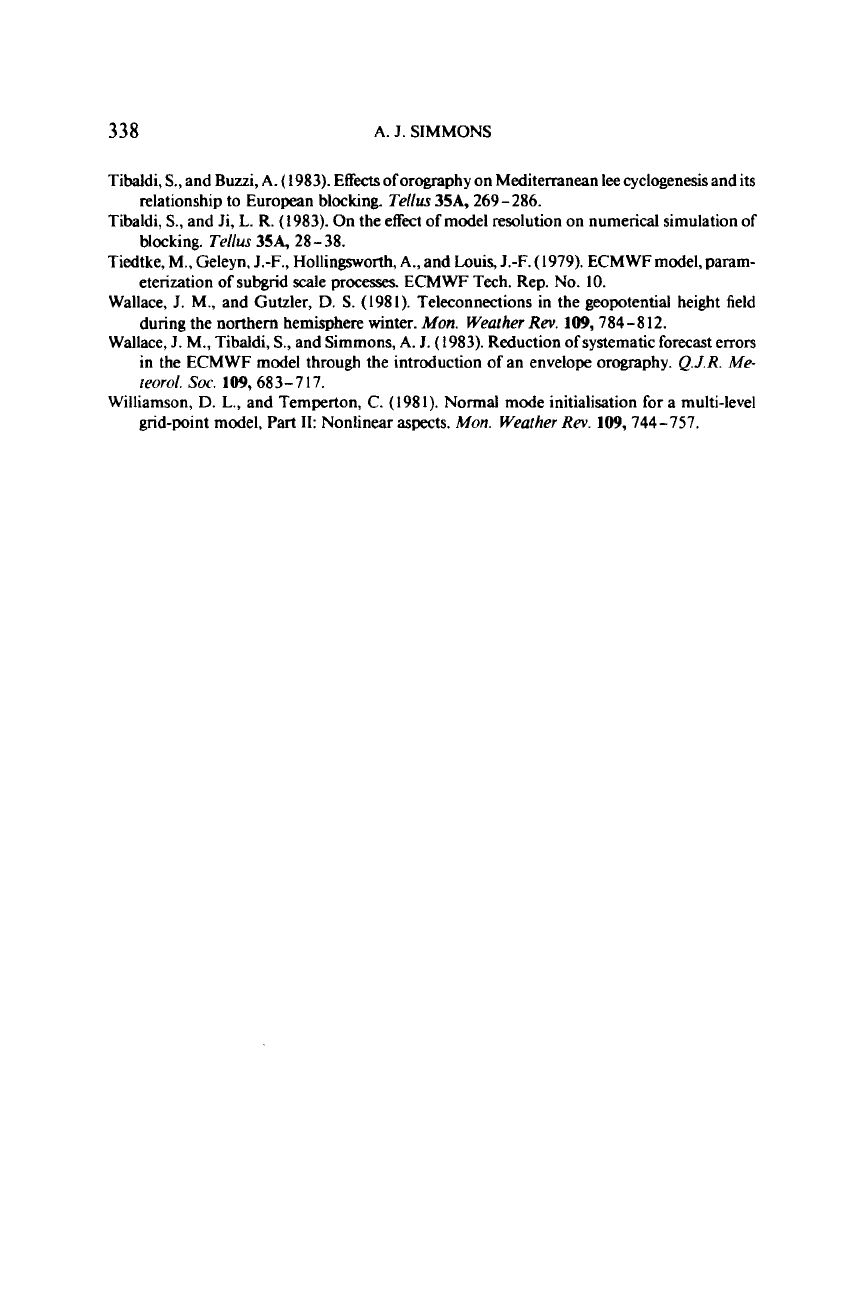
338
A.
J.
SIMMONS
Tibaldi,
S.,
and Buzzi,
A.
(
1983). Effectsoforography on Mediterranean lee cyclogenesis and its
relationship to European blocking.
Tellus
35A, 269-286.
Tibaldi,
S.,
and Ji,
L.
R.
(1983). On the effect
of
model resolution on numerical simulation
of
blocking.
Tellus
35A,28- 38.
Tiedtke, M., Geleyn,
J.-F.,
Hollingsworth,
A.,
and
Louis,
J.-F.
(1979). ECMWF model, param-
eterization
of
subgrid scale processes. ECMWF Tech. Rep. No.
10.
Wallace,
J.
M., and Gutzler,
D.
S.
(1981). Teleconnections in the geopotential height field
during the northern hemisphere winter.
Mon.
Weather
Rev.
109,784-812.
Wallace,
J.
M., Tibaldi,
S.,
and Simmons,
A.
J.
(1983). Reduction
of
systematic forecast errors
in the ECMWF model through the introduction
of
an envelope orography.
Q.J.R.
Me-
leorol.
Soc.
109,683-717.
Williamson,
D.
L.,
and Temperton, C.
(1981).
Normal mode initialisation
for
a multi-level
grid-point model,
Part
11:
Nonlinear
aspects,
Mon.
Weather
Rev.
109,744-757.
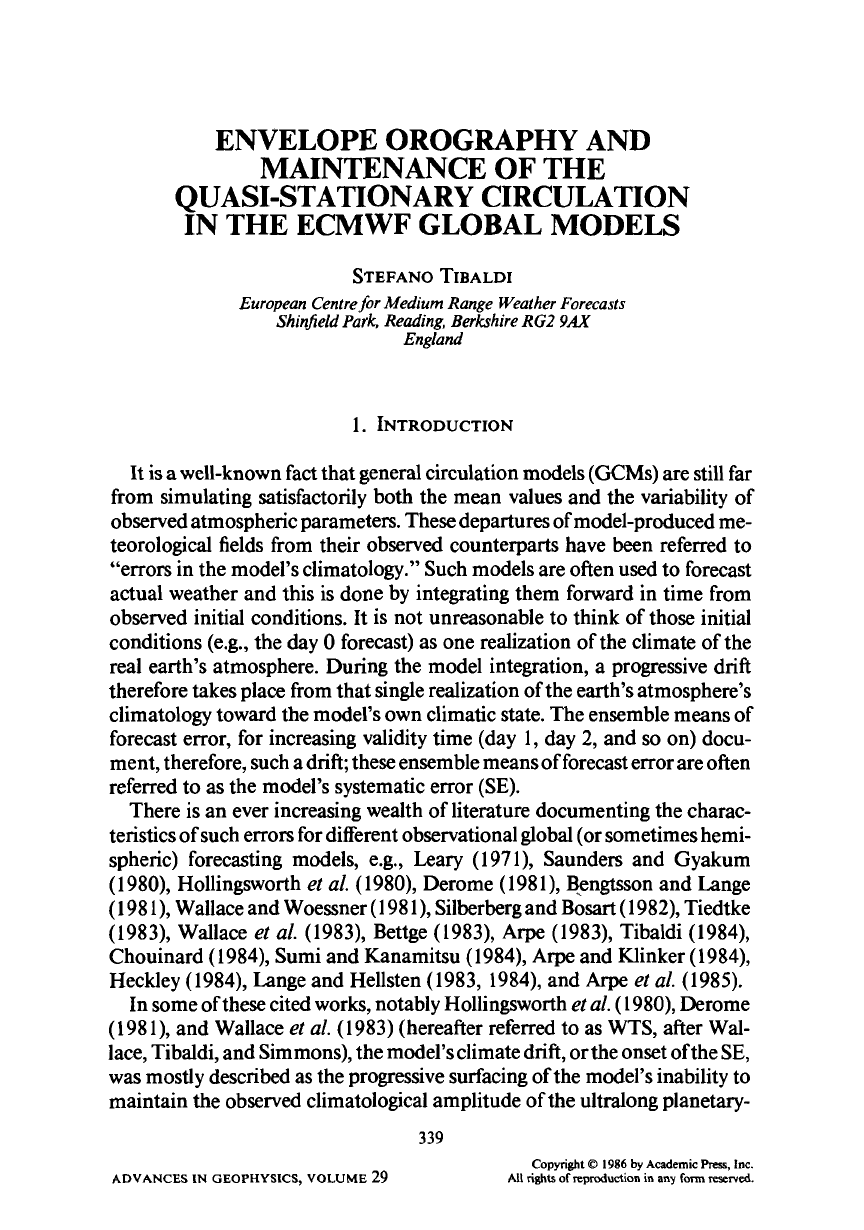
ENVELOPE OROGRAPHY AND
MAINTENANCE OF THE
IN THE ECMWF GLOBAL MODELS
QUASI-STATIONARY CIRCULATION
STEFANO TIBALDI
European Centrejor Medium Range Weather Forecasts
Shinfeld Park. Reading, Berhhire RG2
9AX
England
1.
INTRODUCTION
It is a well-known fact that general circulation models
(GCMs)
are still far
from simulating satisfactorily both the mean values and the variability of
observed atmospheric parameters. These departures of model-produced me-
teorological fields from their observed counterparts have been referred to
“errors in the model’s climatology.” Such models are often used to forecast
actual weather and this is done by integrating them forward in time from
observed initial conditions. It is not unreasonable to think of those initial
conditions (e.g., the
day
0
forecast) as one realization of the climate of the
real earth’s atmosphere. During the model integration, a progressive drift
therefore takes place from that single realization of the earth’s atmosphere’s
climatology toward the model’s own climatic state. The ensemble means of
forecast error, for increasing validity time (day
1,
day
2,
and
so
on) docu-
ment, therefore, such a drift; these ensemble means of forecast error are often
referred to as the model’s systematic error
(SE).
There is an ever increasing wealth of literature documenting the charac-
teristics of such errors for different observational global (or sometimes hemi-
spheric) forecasting models, e.g., Leary
(1971),
Saunders and Gyakum
(
1980),
Hollingsworth
et
al.
(
1980),
Derome
(
198 l),
Bengtsson and Lange
(1
98 I),
Wallace and Woessner
(1
98
l),
Silberberg and Bosart
(
1982),
Tiedtke
(1983),
Wallace
et
al.
(1983),
Bettge
(1983),
Arpe
(1983),
Tibaldi
(1984),
Chouinard
(1984),
Sumi and Kanamitsu
(1984),
Arpe
and Klinker
(1984),
Heckley
(
1984),
Lange and Hellsten
(
1983, 1984),
and
Arpe
et
al.
(1 985).
In some of these cited works, notably Hollingsworth
et
al.
(
1980),
Derome
(1
98 l),
and Wallace
et
al.
(1983)
(hereafter referred to
as
WTS, after Wal-
lace, Tibaldi, and Simmons), the model’s climate drift, or the onset of the
SE,
was mostly described
as
the progressive surfacing of the model’s inability to
maintain the observed climatological amplitude of the ultralong planetary-
339
Copyright
0
1986
by
Academic
Press,
Inc.
All
rights
of
npmduction in
any
form
re~e~ed.
ADVANCES
IN
GEOPHYSICS,
VOLUME
29
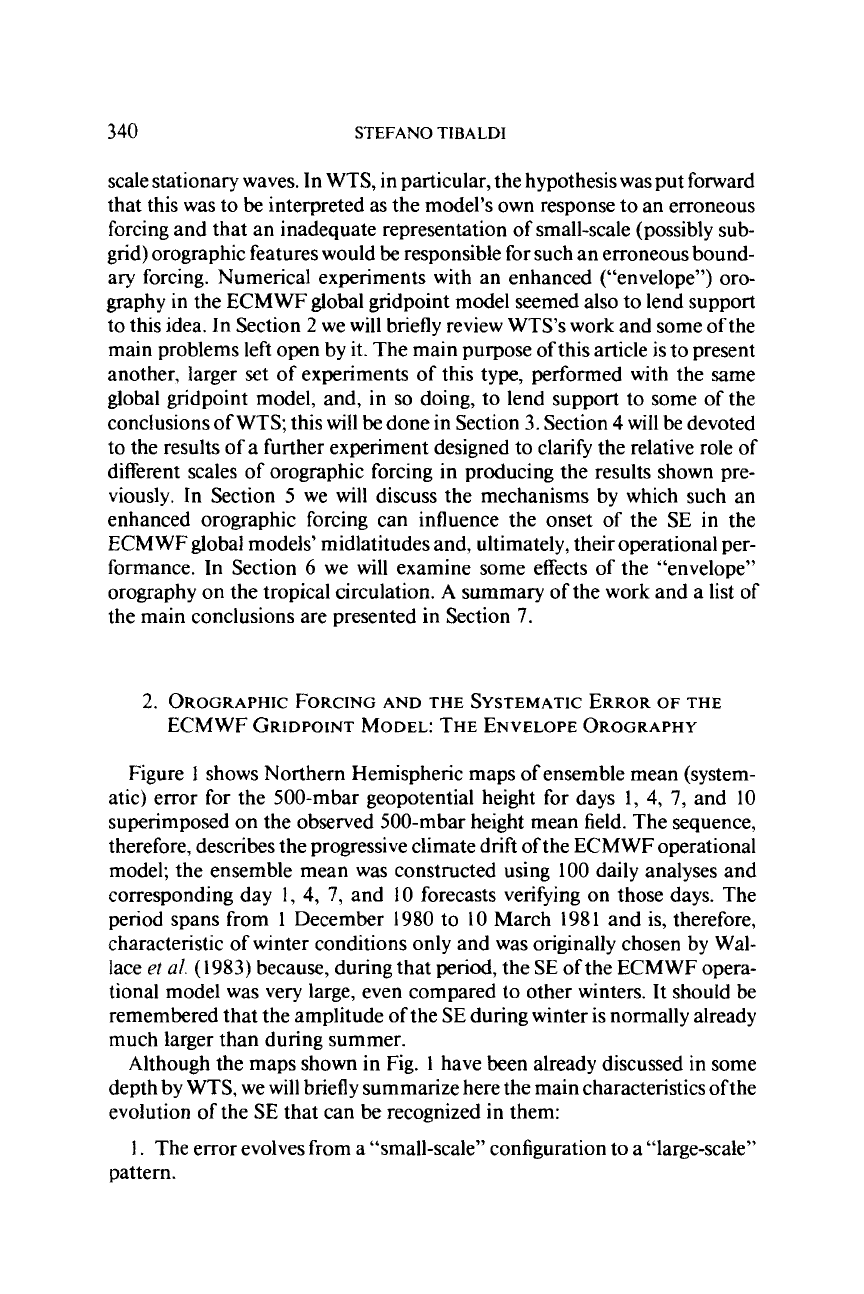
340
STEFAN0
TIBALDI
scale stationary waves. In WTS, in particular, the hypothesis was put forward
that this was to
be
interpreted as the model’s own response to an erroneous
forcing and that an inadequate representation of small-scale (possibly sub-
grid) orographic features would
be
responsible for such an erroneous bound-
ary forcing. Numerical experiments with an enhanced (“envelope”) oro-
graphy in the
ECMWF
global gridpoint model seemed also to lend support
to this idea. In Section
2
we will briefly review WTS’s work and some of the
main problems left open by it. The main purpose of this article is to present
another, larger set of experiments of this type, performed with the same
global gridpoint model, and, in
so
doing, to lend support to some of the
conclusions of WTS; this
will
be
done in Section
3.
Section
4
will be devoted
to the results of a further experiment designed to clarify the relative role of
different scales of orographic forcing in producing the results shown pre-
viously. In Section
5
we
will
discuss the mechanisms by which such an
enhanced orographic forcing can influence the onset of the SE in the
ECMWF global models’ midlatitudes and, ultimately, their operational per-
formance. In Section
6
we will examine some effects of the “envelope”
orography on the tropical circulation.
A
summary of the work and a list of
the main conclusions are presented in Section
7.
2.
OROGRAPHIC
FORCING
AND
THE
SYSTEMATIC
ERROR
OF
THE
ECMWF
GRIDPOINT
MODEL:
THE
ENVELOPE
OROGRAPHY
Figure
1
shows Northern Hemispheric maps of ensemble mean (system-
atic) error for the 500-mbar geopotential height for days 1,
4,
7,
and
10
superimposed on the observed 500-mbar height mean field. The sequence,
therefore, describes the progressive climate drift of the ECMWF operational
model; the ensemble mean was constructed using
100
daily analyses and
corresponding day
1,
4,
7,
and
10
forecasts verifying on those days. The
period spans from
1
December 1980 to
10
March 1981 and is, therefore,
characteristic of winter conditions only and was originally chosen by Wal-
lace
et
al.
(
1983) because, during that
period,
the
SE
of the ECMWF opera-
tional model was very large, even compared to other winters. It should be
remembered that the amplitude of the
SE
during winter is normally already
much larger than during summer.
Although the maps shown in Fig.
1
have been already discussed in some
depth by WTS, we will briefly summarize here the main characteristics of the
evolution of the
SE
that can be recognized in them:
1.
The error evolves from a “small-scale” configuration to a “large-scale”
pattern.
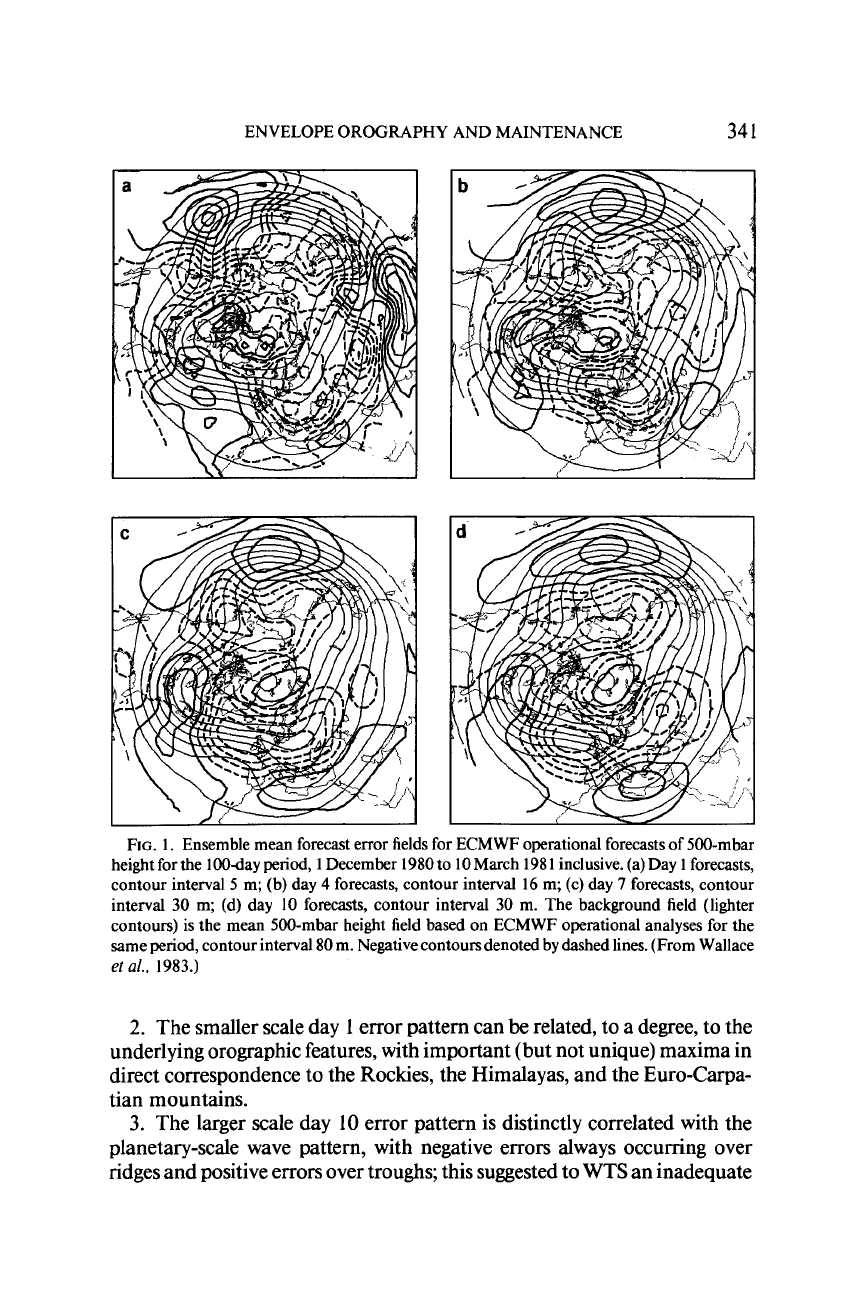
ENVELOPE OROGRAPHY AND MAINTENANCE
34
1
FIG.
1.
Ensemble mean forecast error fields
for
ECMWF operational forecasts
of
500-mbar
height for the 100-day
period,
1
December I980 to
10
March 198
1
inclusive. (a) Day
1
forecasts,
contour interval 5 m; (b) day
4
forecasts, contour interval 16 m; (c) day
7
forecasts, contour
interval 30 m; (d) day
10
forecasts, contour interval 30 m. The background field (lighter
contours) is the mean 500-mbar height field based on ECMWF operational analyses
for
the
same
period,
contour interval 80 m. Negative contours denoted by dashed lines. (From Wallace
et
al.,
1983.)
2.
The smaller scale day
1
error pattern can
be
related, to a degree,
to
the
underlying orographic features, with important (but not unique) maxima in
direct correspondence to the Rockies, the Himalayas, and the Euro-Carpa-
tian mountains.
3.
The larger scale day
10
error pattern is distinctly correlated with the
planetary-scale wave pattern, with negative errors always occurring over
ridges and positive errors over troughs; this suggested to
WTS
an inadequate
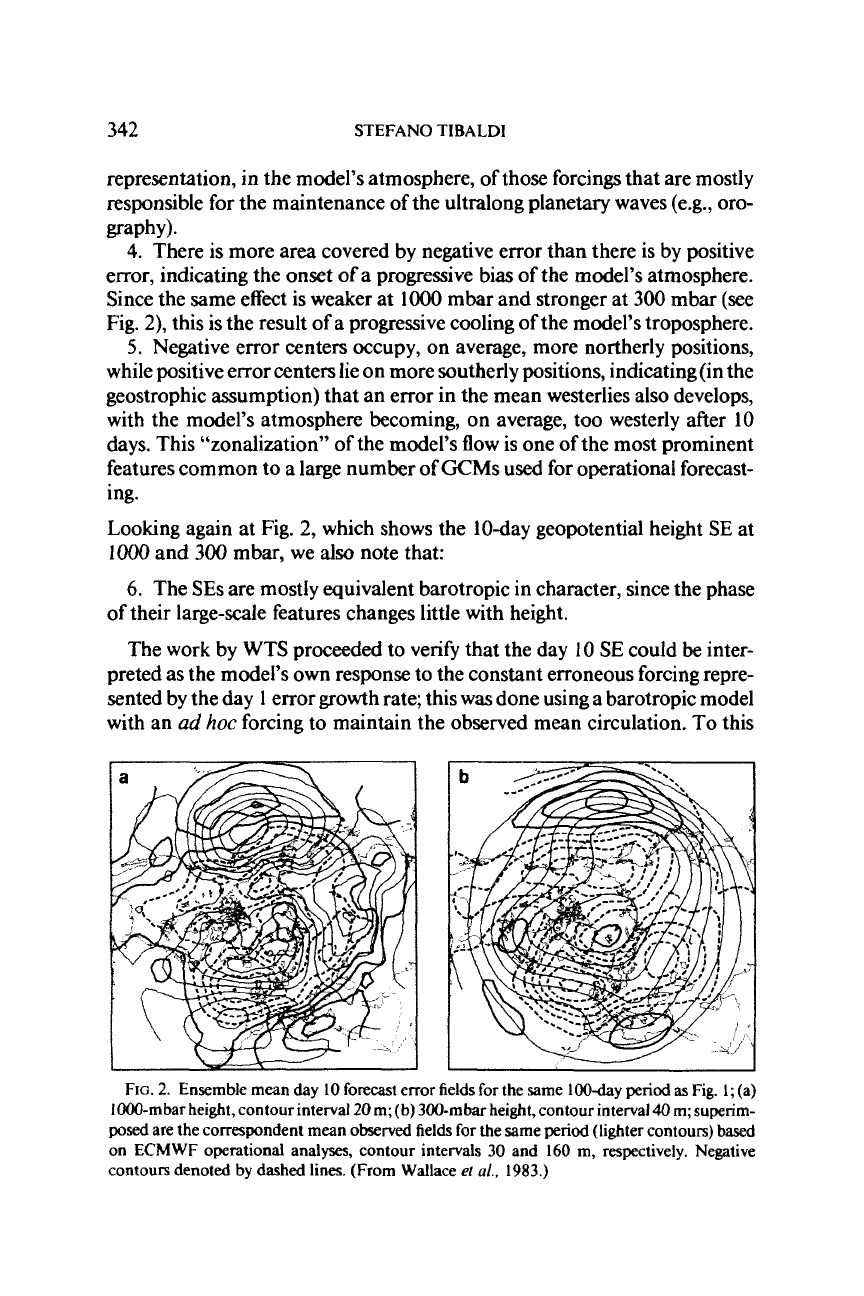
342
STEFAN0 TIBALDI
representation, in the model’s atmosphere, of those forcings that are mostly
responsible
for
the maintenance of the ultralong planetary waves (e.g., oro-
graphy).
4.
There is more area covered by negative error than there is by positive
error, indicating the onset
of
a progressive bias of the model’s atmosphere.
Since the same effect is weaker at
loo0
mbar and stronger at
300
mbar (see
Fig.
2),
this is the result of
a
progressive cooling of the model’s troposphere.
5.
Negative error centers occupy, on average, more northerly positions,
while positive error centers lie on more southerly positions, indicating (in the
geostrophic assumption) that an error in the mean westerlies also develops,
with the model’s atmosphere becoming, on average, too westerly after
10
days, This “zonalization” of the model’s flow is one
of
the most prominent
features common to a large number of
GCMs
used for operationaI forecast-
ing.
Looking again at
Fig.
2,
which shows the 10-day geopotential height
SE
at
1
OOO
and
300
mbar, we
also
note that:
6.
The
SEs
are mostly equivalent barotropic in character, since the phase
of their large-scale features changes little with height.
The work by
WTS
proceeded to verify that the day
10
SE
could
be
inter-
preted as the model’s
own
response to the constant erroneous forcing repre-
sented by the day
1
error growth rate; this
was
done using a barotropic model
with an
ad
hoc
forcing to maintain the observed mean circulation.
To
this
FIG.
2.
Ensemble mean day
10
forecast error fields for the same 1OO-day
period
as
Fig. 1; (a)
IW-mbar
height, contour interval
20
m;
(b)
300-mbar
height,
contour
interval
40
m;
superim-
posed
are the correspondent mean
observed
fields for the same
period
(lighter contours) based
on
ECMWF operational analyses, contour intervals
30
and
160
m, respectively. Negative
contours denoted by dashed
lines.
(From Wallace
et
al..
1983.)

ENVELOPE OROGRAPHY AND MAINTENANCE
343
main forcing an additional forcing was superimposed, proportional to the
day
1
error growth rate. The strong resemblance between the model’s day 10
response to such an additional forcing and the observed day
10
error added
additional confidence to the “erroneous forcing” hypothesis made by WTS.
A
number of
IO-day
forecasts were then attempted using an enhanced
(“envelope”) orography’ that showed, even within the limits of the small
sample,
a
remarkably reduced SE, more notably around day
7.
The reader
was then left with a note of caution regarding the fact that the observed
decrease of the SE in the later stages ofthe forecast ensemble seemed to occur
despite much less convincing changes in the
day
1
SE pattern, showing no
apparent reduction or even a small increase, at least in some areas. The limits
imposed on the applicability of the WTS result to other situations by the
smallness of the sample of forecasts is obvious, and this was also pointed out.
The possibility of incorporating some sort of envelope orography in the
ECMWF operational forecasting required experimentation based on a
much larger sample of cases. It was then decided that January 198
1,
with the
largest ever systematic error in the Northern Hemisphere, was an ideal test
period. In the next section we will describe in some detail this set of experi-
ments. Some preliminary results were reported in Tibaldi
(1
984).
3.
THE
JANUARY
1981 SET
OF
EXPERIMENTS
We will now describe a larger set of experiments of the same type as
described in WTS, that is, “mean” against “envelope” orography 10-day
forecasts. In order to maintain the experiment as unbiased
as
possible and
eliminate all additional causes of different behavior, the global observed data
for the whole of January 198
1
were reassimilated twice with the ECMWF
operational
data
assimilation system, once using a mean orography in the
assimilating model and once using a 2ph envelope orography. Then
2
X
3
1
1
0-day forecasts were run from the 1200 GMT analysis of every
day
with the
two different orographies, and these two ensembles of forecasts were com-
pared. It should be pointed out that, in the envelope ensemble, a correction
was made to the soil temperature, soil moisture, and snow cover fields to
allow
for the vertical displacement of the ground surface, to minimize the
spurious thermal effects coming from an enhanced orography and to focus
on the mechanical effects alone as much as possible.
I
Thegridpoint“envelope”orography(h,)(Wallaceetal.,
1983)wasconstmctedas themean
terrain height defined on the gridbox
(h,)
plus a given proportion of the standard deviation
of
such terrain heightp,,
as
computed from a dataset of much higher spatial resolution than the grid
of
the model, namely the
U.S.
Navy global orography dataset. In the
WTS
experiments the
proportion
of
standard deviation added to the mean was
2,
e.g.,
h,
=
h,
+
2pb.
